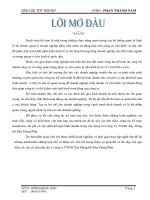Lecture Steganography: Steganographic - Ho Dac Hung
Bạn đang xem bản rút gọn của tài liệu. Xem và tải ngay bản đầy đủ của tài liệu tại đây (288.71 KB, 19 trang )
Steganographic channels
Ho Dac Hung
1
Contents
•
•
•
•
Problem
Steganography by cover selection
Steganography by cover synthesis
Steganography by cover modification
2
1. Problem
3
1. Problem
4
1. Problem
• Passive warden scenario
• Active warden scenario
• Malicious warden scenario
5
1. Problem
• The problem of steganography can thus be
formulated as finding embedding and
extraction algorithms for a given cover source
that enable communication of reasonably
large messages without introducing any
embedding artifacts that could be detected by
the warden. In other words, the goal is to
embed secret messages undetectably.
6
2. Steganography by cover selection
• In steganography by cover selection, Alice has
available a fixed database of images from
which she selects one that communicates the
desired message.
7
2. Steganography by cover selection
• The embedding algorithm can work simply by
randomly drawing images from the database
till an image is found that communicates the
desired message.
• The stego key here is essentially the set of
rules that tell Alice and Bob how to interpret
the images.
8
2. Steganography by cover selection
• An important case of steganography by cover
selection involves message-digest (hash)
functions.
h(x) = {x[1] mod 2, x[2] mod 2, x[3] mod 2}
9
3. Steganography by cover synthesis
• In steganography by cover synthesis, Alice
creates the cover so that it conveys the
desired message.
• Steganography by cover synthesis could be
combined with steganography by cover
selection to alleviate the exponential
complexity of embedding by hashing.
10
3. Steganography by cover synthesis
11
3. Steganography by cover synthesis
• Let us assume that the images are 8-bit
grayscale with xj[i] standing for the intensity of
the ith pixel in the jth image, i = 1, . . . , n; j = 1,
. . . , K.
• Alice will use a cryptographic hash function
modified to return 4 bits when applied to 16
pixels.
12
3. Steganography by cover synthesis
• Alice divides every image into disjoint blocks
of 4 × 4 pixels and assembles a new image in a
block-by-block fashion so that each 4 × 4 block
conveys 4 message bits.
• To embed the first 4 bits in the first 4 × 4 block
of pixels, Alice searches through the hashes
h(xj[1], . . . , xj[16]), j ∈ {1, 2, . . . , K} till she
finds a match between the hash of the first 16
pixels and the message, which will happen for
image number j1.
13
3. Steganography by cover synthesis
• Then, she moves to the next block and finds j2
∈ {1, . . . , K} so that h(xj[17], . . . , xj[32])
matches the next 4 message bits, etc.
• The final stego image y will be a mosaic
assembled from blocks from different images
y = (xj1[1], . . . , xj1[16], xj2[17], . . . , xj2[32],
xj3[33], . . .).
14
3. Steganography by cover synthesis
• The probability of finding a match in one
particular block among all K images is 1 − (1 −
1/16)K.
• The probability of being able to embed the
whole message, which consists of n/16 groups
of 4 bits is thus (1 − (1 − 1/16)K)n/16.
15
4. Steganography by cover
modification
• Alice starts with a cover image and makes
modifications to it in order to embed secret
data.
• Alice and Bob work with the set of all possible
covers and the sets of keys and messages that
may, in the most general case, depend on
each cover.
16
4. Steganography by cover
modification
• C: set of cover objects x Є C
• K(x): set of all stego keys for x
• M(x): set of all messages that can be
communicated in x
• Emb: C x K x M C
• Ext: C x K M
17
4. Steganography by cover
modification
18
4. Steganography by cover
modification
• we define the embedding capacity (payload)
of cover x in bits as log 2 𝑀(𝑥) and the
log2 𝑀(𝑥)
𝑛
relative embedding capacity is
n is the number of elements in x.
where
19








